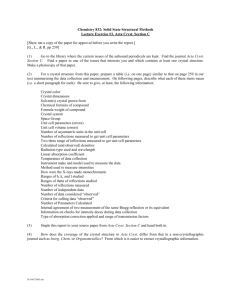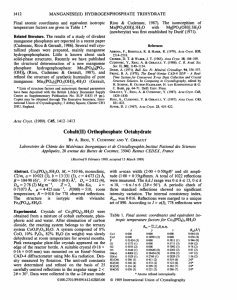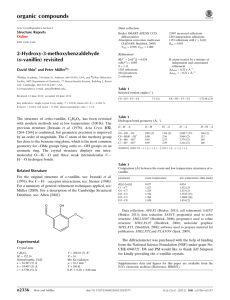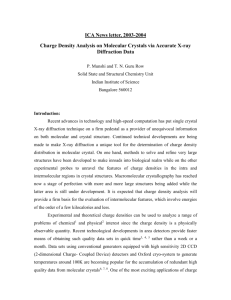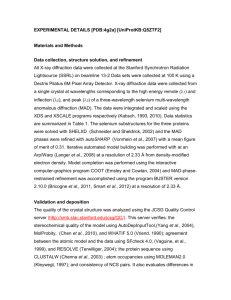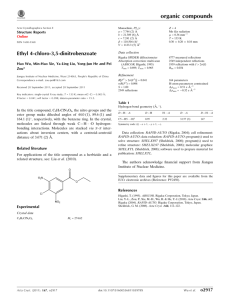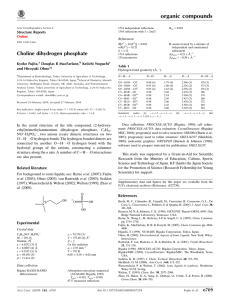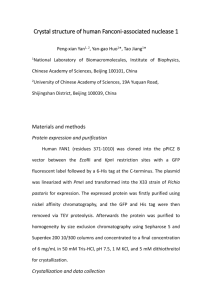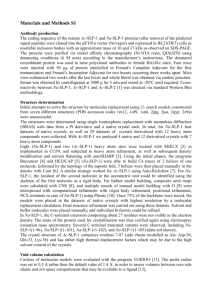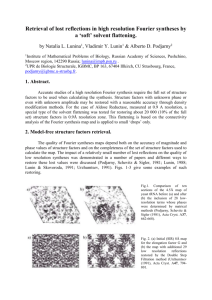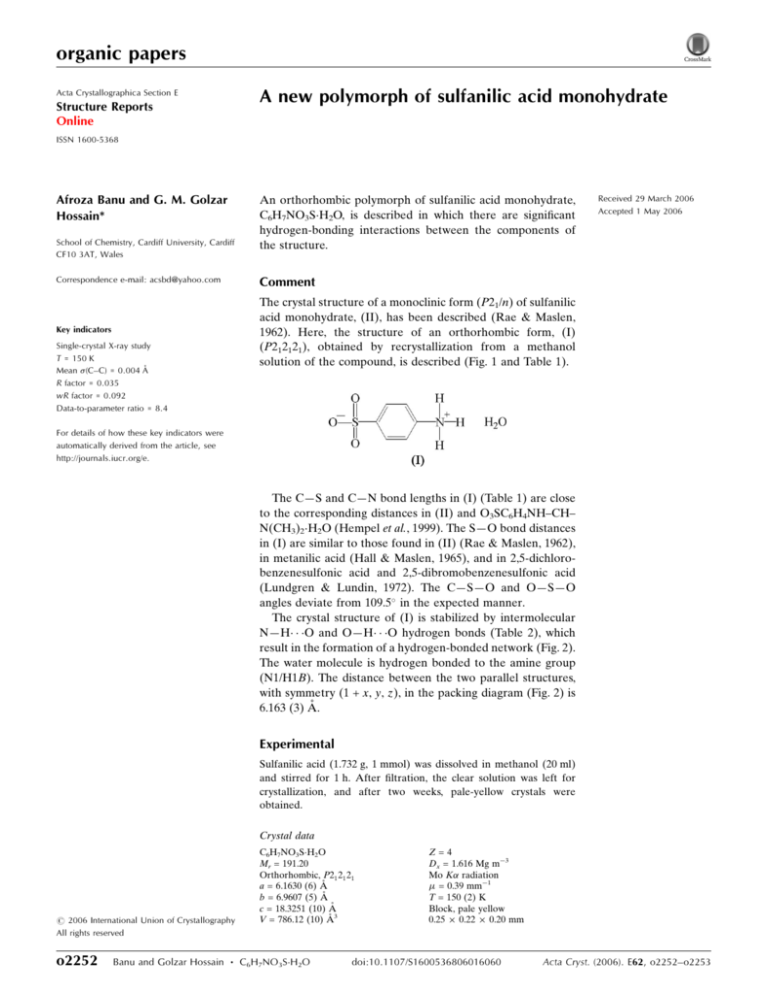
organic papers
A new polymorph of sulfanilic acid monohydrate
Acta Crystallographica Section E
Structure Reports
Online
ISSN 1600-5368
Afroza Banu and G. M. Golzar
Hossain*
School of Chemistry, Cardiff University, Cardiff
CF10 3AT, Wales
An orthorhombic polymorph of sulfanilic acid monohydrate,
C6H7NO3SH2O, is described in which there are significant
hydrogen-bonding interactions between the components of
the structure.
Correspondence e-mail: acsbd@yahoo.com
Comment
Key indicators
The crystal structure of a monoclinic form (P21/n) of sulfanilic
acid monohydrate, (II), has been described (Rae & Maslen,
1962). Here, the structure of an orthorhombic form, (I)
(P212121), obtained by recrystallization from a methanol
solution of the compound, is described (Fig. 1 and Table 1).
Single-crystal X-ray study
T = 150 K
Mean (C–C) = 0.004 Å
R factor = 0.035
wR factor = 0.092
Data-to-parameter ratio = 8.4
Received 29 March 2006
Accepted 1 May 2006
For details of how these key indicators were
automatically derived from the article, see
http://journals.iucr.org/e.
The C—S and C—N bond lengths in (I) (Table 1) are close
to the corresponding distances in (II) and O3SC6H4NH–CH–
N(CH3)2H2O (Hempel et al., 1999). The S—O bond distances
in (I) are similar to those found in (II) (Rae & Maslen, 1962),
in metanilic acid (Hall & Maslen, 1965), and in 2,5-dichlorobenzenesulfonic acid and 2,5-dibromobenzenesulfonic acid
(Lundgren & Lundin, 1972). The C—S—O and O—S—O
angles deviate from 109.5 in the expected manner.
The crystal structure of (I) is stabilized by intermolecular
N—H O and O—H O hydrogen bonds (Table 2), which
result in the formation of a hydrogen-bonded network (Fig. 2).
The water molecule is hydrogen bonded to the amine group
(N1/H1B). The distance between the two parallel structures,
with symmetry (1 + x, y, z), in the packing diagram (Fig. 2) is
6.163 (3) Å.
Experimental
Sulfanilic acid (1.732 g, 1 mmol) was dissolved in methanol (20 ml)
and stirred for 1 h. After filtration, the clear solution was left for
crystallization, and after two weeks, pale-yellow crystals were
obtained.
Crystal data
# 2006 International Union of Crystallography
All rights reserved
o2252
Banu and Golzar Hossain
C6H7NO3SH2O
Mr = 191.20
Orthorhombic, P21 21 21
a = 6.1630 (6) Å
b = 6.9607 (5) Å
c = 18.3251 (10) Å
V = 786.12 (10) Å3
C6H7NO3SH2O
Z=4
Dx = 1.616 Mg m3
Mo K radiation
= 0.39 mm1
T = 150 (2) K
Block, pale yellow
0.25 0.22 0.20 mm
doi:10.1107/S1600536806016060
Acta Cryst. (2006). E62, o2252–o2253
organic papers
Data collection
957 independent reflections
793 reflections with I > 2(I)
Rint = 0.024
max = 26.3
3 standard reflections
every 134 reflections
intensity decay: none
Enraf–Nonius CAD-4
diffractometer
!/ scans
Absorption correction: part of the
refinement model (F)
(Walker & Stuart, 1983)
Tmin = 0.910, Tmax = 0.927
1822 measured reflections
Refinement
Refinement on F 2
R[F 2 > 2(F 2)] = 0.035
wR(F 2) = 0.092
S = 1.04
957 reflections
114 parameters
H atoms treated by a mixture of
independent and constrained
refinement
w = 1/[ 2(Fo2) + (0.0544P)2
+ 0.1313P]
where P = (Fo2 + 2Fc2)/3
(/)max = 0.001
max = 0.31 e Å3
min = 0.29 e Å3
Figure 1
The asymmetric unit of (I), showing the atom-labelling scheme.
Displacement ellipsoids are drawn at the 35% probability level. The
hydrogen bond is shown as a dashed line.
Table 1
Selected geometric parameters (Å, ).
S1—O1
S1—O2
S1—O3
1.448 (3)
1.459 (3)
1.446 (3)
O1—S1—O2
O1—S1—O3
O1—S1—C1
S1—C1
N1—C4
111.64 (19)
113.77 (19)
106.26 (15)
1.773 (3)
1.468 (4)
O2—S1—O3
O2—S1—C1
O3—S1—C1
112.15 (15)
105.00 (15)
107.36 (15)
Figure 2
The molecular packing of (I), viewed approximately along the a axis.
Dashed lines indicate the hydrogen-bonding interactions.
Table 2
Hydrogen-bond geometry (Å, ).
D—H A
i
O4—H4A O1
O4—H4B O2ii
N1—H1A O3iii
N1—H1B O4
N1—H1C O2iv
D—H
H A
D A
D—H A
0.95
0.95
0.94
0.93
0.96
1.90
1.89
1.97
1.84
1.95
2.821
2.838
2.846
2.738
2.895
163
175
154
160
166
Symmetry codes: (i) x þ 12; y þ 1; z 12;
x 12; y þ 12; z þ 1; (iv) x 12; y þ 32; z þ 1.
(ii)
(3)
(4)
(4)
(3)
(4)
x þ 12; y þ 32; z þ 1;
(iii)
Windows (Farrugia, 1997); software used to prepare material for
publication: WinGX (Farrugia, 1999).
GMGH acknowledges the Ministry of Science and Technology, The People’s Republic of Bangladesh, for the award of
a Bangabandhu Fellowship.
References
In the absence of significant anomalous scattering, Friedel pairs
were merged before the final refinement. C-bound H atoms were
included in the riding model approximation with C—H = 0.95 Å, and
with Uiso(H) = 1.2Ueq(C). H atoms attached to N and O(water) were
located from an electron density map, fixed in these positions and
assigned individual isotropic displacement parameters; see Table 2
for bond distances.
Data collection: CAD-4 EXPRESS (Enraf–Nonius, 1992); cell
refinement: CAD-4 EXPRESS; data reduction: CAD-4 Processing
Program (Hursthouse, 1976); program(s) used to solve structure:
SHELXS97 (Sheldrick, 1990); program(s) used to refine structure:
SHELXL97 (Sheldrick, 1997); molecular graphics: ORTEP-3 for
Acta Cryst. (2006). E62, o2252–o2253
Enraf–Nonius (1992). CAD-4 EXPRESS. Enraf-Nonius, Delft, The Netherlands.
Farrugia, L. J. (1997). J. Appl. Cryst. 30, 565.
Farrugia, L. J. (1999). J. Appl. Cryst. 32, 837–838.
Hall, S. R. & Maslen, E. N. (1965). Acta Cryst. 18, 301–306.
Hempel, A., Camerman, N., Mastropaolo, D. & Camerman, A. (1999). Acta
Cryst. C55, 697–698.
Hursthouse, M. B. (1976). CAD-4 Processing Program. Queen Mary College,
London.
Lundgren, J.-O. & Lundin, P. (1972). Acta Cryst. B28, 486–491.
Rae, A. I. M. & Maslen, E. N. (1962). Acta Cryst. 15, 1285–1291.
Sheldrick, G. M. (1990). Acta Cryst. A46, 467–473.
Sheldrick, G. M. (1997). SHELXL97. University of Gottingen, Germany.
Walker, N. & Stuart, D. (1983). Acta Cryst. A39, 158–166.
Banu and Golzar Hossain
C6H7NO3SH2O
o2253
supporting information
supporting information
Acta Cryst. (2006). E62, o2252–o2253
[doi:10.1107/S1600536806016060]
A new polymorph of sulfanilic acid monohydrate
Afroza Banu and G. M. Golzar Hossain
S1. Comment
The crystal structure of the monoclinic form (P21/n) of sulfanilic acid monohydrate, (II), has been described (Rae &
Maslen, 1962). Here, the structure of the orthorhombic form, (I) (P212121), obtained from recrystallization from a
methanol solution of the compound, is described (Fig. 1 and Table 1).
The C—S and C—N bond lengths in (I) (Table 1) are close to the corresponding distances in (II) and O3SC6H4NH–CH–
N(CH3)2·H2O (Hempel et al., 1999). In the same way, the S—O bond distances in (I) are similar to those found in (II)
(Rae & Maslen, 1962), in metanilic acid (Hall & Maslen, 1965), and in 2,5-dichlorobenzenesulfonic acid and 2,5-dibromobenzenesulfonic acid (Lundgren & Lundin, 1972). The C—S—O and O—S—O angles deviate from 109.5° in the
expected manner.
The crystal structure of (I) is stabilized by intermolecular N—H···O and O—H···O hydrogen bonds (Table 2), which
result in the formation of a hydrogen-bonded network (Fig. 2). The water molecule is hydrogen bonded to the amine
group (N1/H1B). The distance between the two parallel structures in the packing diagram (Fig. 2) is 6.163 (s.u.?) Å.
S2. Experimental
Sulfanilic acid (1.732 g, 1 mmol) was dissolved in methanol (20 ml) and stirred for 1 h. After filtration, the clear solution
was left for crystallization, and after two weeks, pale-yellow crystals were obtained.
S3. Refinement
As there are no significant anomalous scatterers in the molecule, attempts to confirm the absolute structure by refinement
of the Flack (1983) parameter in the presence of 577 pairs of Friedel equivalents led to an inconclusive value for the
parameter. Therefore, Friedel pairs were merged before the final refinement. C-bound H atoms were included in the
riding model approximation with C—H = 0.95 Å, and with Uiso(H) = 1.2Ueq(C). H atoms attached to N and O(water) were
located from an electron density map, fixed in these positions and refined isotropically; see Table 2 for bond distances.
Acta Cryst. (2006). E62, o2252–o2253
sup-1
supporting information
Figure 1
View of (I), showing the atom-labelling scheme. Displacement ellipsoids are drawn at the 35% probability level. The
intramolecular hydrogen bond is shown as a dashed line.
Figure 2
The molecular packing of (I), viewed along the a axis. Dashed lines indicate the hydrogen-bonding interactions.
sulfanilic acid monohydrate
Crystal data
C6H7NO3S·H2O
Mr = 191.20
Orthorhombic, P212121
Hall symbol: P 2ac 2ab
a = 6.1630 (6) Å
b = 6.9607 (5) Å
c = 18.3251 (10) Å
V = 786.12 (10) Å3
Z=4
Acta Cryst. (2006). E62, o2252–o2253
F(000) = 400
Dx = 1.616 Mg m−3
Mo Kα radiation, λ = 0.71073 Å
Cell parameters from 957 reflections
θ = 2.9–26.3°
µ = 0.39 mm−1
T = 150 K
Block, pale yellow
0.25 × 0.22 × 0.20 mm
sup-2
supporting information
Data collection
Enraf–Nonius CAD-4
diffractometer
Radiation source: fine-focus sealed tube
Graphite monochromator
ω/θ scans
Absorption correction: part of the refinement
model (ΔF)
(Walker & Stuart, 1983)
Tmin = 0.910, Tmax = 0.927
3 measured reflections
957 independent reflections
793 reflections with I > 2σ(I)
Rint = 0.024
θmax = 26.3°, θmin = 2.2°
h = −7→0
k = −8→2
l = −22→22
1534 standard reflections every 134 reflections
intensity decay: none
Refinement
Refinement on F2
Least-squares matrix: full
R[F2 > 2σ(F2)] = 0.035
wR(F2) = 0.092
S = 1.04
957 reflections
114 parameters
5 restraints
Primary atom site location: structure-invariant
direct methods
Secondary atom site location: difference Fourier
map
Hydrogen site location: inferred from
neighbouring sites
H atoms treated by a mixture of independent
and constrained refinement
w = 1/[σ2(Fo2) + (0.0544P)2 + 0.1313P]
where P = (Fo2 + 2Fc2)/3
(Δ/σ)max = 0.001
Δρmax = 0.31 e Å−3
Δρmin = −0.29 e Å−3
Absolute structure: Flack (1983)
Special details
Geometry. All e.s.d.'s (except the e.s.d. in the dihedral angle between two l.s. planes) are estimated using the full
covariance matrix. The cell e.s.d.'s are taken into account individually in the estimation of e.s.d.'s in distances, angles and
torsion angles; correlations between e.s.d.'s in cell parameters are only used when they are defined by crystal symmetry.
An approximate (isotropic) treatment of cell e.s.d.'s is used for estimating e.s.d.'s involving l.s. planes.
Refinement. Refinement of F2 against ALL reflections. The weighted R-factor wR and goodness of fit S are based on F2,
conventional R-factors R are based on F, with F set to zero for negative F2. The threshold expression of F2 > σ(F2) is used
only for calculating R-factors(gt) etc. and is not relevant to the choice of reflections for refinement. R-factors based on F2
are statistically about twice as large as those based on F, and R- factors based on ALL data will be even larger.
Fractional atomic coordinates and isotropic or equivalent isotropic displacement parameters (Å2)
S1
O1
O2
O3
O4
N1
C1
C2
H2
C3
H3
C4
C5
x
y
z
Uiso*/Ueq
−0.01053 (14)
0.2228 (4)
−0.1130 (5)
−0.0795 (5)
0.0515 (4)
−0.3138 (4)
−0.1055 (5)
−0.3124 (6)
−0.4084
−0.3807 (6)
−0.5234
−0.2392 (5)
−0.0359 (6)
0.48483 (12)
0.5066 (5)
0.6505 (4)
0.3055 (4)
0.6429 (5)
0.5290 (4)
0.4873 (4)
0.5482 (5)
0.5827
0.5591 (5)
0.6011
0.5081 (5)
0.4401 (5)
0.63841 (4)
0.63447 (13)
0.67294 (13)
0.67078 (13)
0.25576 (15)
0.32896 (13)
0.54710 (15)
0.53154 (17)
0.5699
0.45936 (17)
0.4480
0.40465 (16)
0.41925 (16)
0.0291 (2)
0.0463 (7)
0.0386 (7)
0.0428 (7)
0.0663 (11)
0.0307 (7)
0.0252 (7)
0.0303 (8)
0.036*
0.0307 (8)
0.037*
0.0273 (7)
0.0304 (8)
Acta Cryst. (2006). E62, o2252–o2253
sup-3
supporting information
H5
C6
H6
H1A
H1B
H1C
H4A
H4B
0.0554
0.0381 (4)
0.1797
−0.3781
−0.1976
−0.4142
0.1434
0.1615
0.4006
0.4282 (4)
0.3823
0.4113
0.5436
0.6317
0.6163
0.7184
0.3803
0.49055 (13)
0.5013
0.3158
0.2970
0.3197
0.2156
0.2777
0.036*
0.0299 (8)
0.036*
0.053 (13)*
0.041 (11)*
0.059 (14)*
0.12 (2)*
0.15 (3)*
Atomic displacement parameters (Å2)
S1
O1
O2
O3
O4
N1
C1
C2
C3
C4
C5
C6
U11
U22
U33
U12
U13
U23
0.0329 (4)
0.0293 (13)
0.0500 (18)
0.0549 (19)
0.052 (2)
0.0376 (16)
0.0299 (16)
0.0306 (18)
0.0296 (19)
0.0353 (17)
0.0321 (19)
0.031 (2)
0.0347 (4)
0.079 (2)
0.0387 (13)
0.0419 (14)
0.096 (3)
0.0327 (16)
0.0241 (15)
0.0334 (18)
0.0331 (17)
0.0254 (16)
0.0353 (17)
0.0305 (16)
0.0195 (3)
0.0311 (12)
0.0270 (12)
0.0315 (13)
0.0513 (16)
0.0217 (12)
0.0216 (13)
0.0268 (16)
0.0294 (16)
0.0212 (15)
0.0237 (14)
0.0284 (15)
0.0022 (5)
−0.0029 (16)
0.0017 (14)
0.0020 (14)
−0.025 (2)
−0.0033 (15)
−0.0018 (18)
0.0028 (16)
0.0016 (16)
0.0001 (17)
0.0036 (15)
0.0041 (15)
−0.0003 (3)
−0.0032 (10)
0.0012 (14)
0.0023 (15)
0.0144 (17)
−0.0041 (13)
0.0004 (12)
0.0057 (14)
−0.0019 (14)
−0.0030 (12)
0.0054 (15)
0.0018 (15)
0.0014 (4)
0.0047 (17)
−0.0070 (11)
0.0098 (11)
−0.0228 (18)
0.0000 (12)
0.0007 (13)
−0.0008 (14)
−0.0002 (14)
−0.0001 (15)
−0.0067 (13)
−0.0026 (13)
Geometric parameters (Å, º)
S1—O1
S1—O2
S1—O3
S1—C1
O4—H4A
O4—H4B
N1—C4
N1—H1A
N1—H1B
N1—H1C
1.448 (3)
1.459 (3)
1.446 (3)
1.773 (3)
0.9476
0.9474
1.468 (4)
0.9415
0.9315
0.9606
C1—C2
C1—C6
C2—C3
C2—H2
C3—C4
C3—H3
C4—C5
C5—C6
C5—H5
C6—H6
1.374 (5)
1.424 (4)
1.390 (4)
0.9500
1.376 (5)
0.9500
1.366 (5)
1.386 (4)
0.9500
0.9500
O1—S1—O2
O1—S1—O3
O1—S1—C1
O2—S1—O3
O2—S1—C1
O3—S1—C1
H4A—O4—H4B
C4—N1—H1A
C4—N1—H1B
H1A—N1—H1B
111.64 (19)
113.77 (19)
106.26 (15)
112.15 (15)
105.00 (15)
107.36 (15)
90.5
106.8
111.4
104.9
C1—C2—C3
C1—C2—H2
C3—C2—H2
C4—C3—C2
C4—C3—H3
C2—C3—H3
C5—C4—C3
C5—C4—N1
C3—C4—N1
C4—C5—C6
119.7 (3)
120.2
120.2
119.2 (3)
120.4
120.4
121.9 (3)
120.4 (3)
117.7 (3)
120.5 (3)
Acta Cryst. (2006). E62, o2252–o2253
sup-4
supporting information
C4—N1—H1C
H1A—N1—H1C
H1B—N1—H1C
C2—C1—C6
C2—C1—S1
C6—C1—S1
116.3
109.3
107.6
121.0 (3)
120.4 (2)
118.6 (2)
C4—C5—H5
C6—C5—H5
C5—C6—C1
C5—C6—H6
C1—C6—H6
119.8
119.8
117.7 (3)
121.2
121.2
Hydrogen-bond geometry (Å, º)
D—H···A
i
O4—H4a···O1
O4—H4b···O2ii
N1—H1a···O3iii
N1—H1b···O4
N1—H1c···O2iv
D—H
H···A
D···A
D—H···A
0.95
0.95
0.94
0.93
0.96
1.90
1.89
1.97
1.84
1.95
2.821 (3)
2.838 (4)
2.846 (4)
2.738 (3)
2.895 (4)
163
175
154
160
166
Symmetry codes: (i) −x+1/2, −y+1, z−1/2; (ii) x+1/2, −y+3/2, −z+1; (iii) x−1/2, −y+1/2, −z+1; (iv) x−1/2, −y+3/2, −z+1.
Acta Cryst. (2006). E62, o2252–o2253
sup-5

